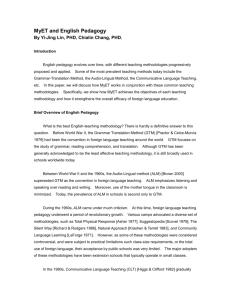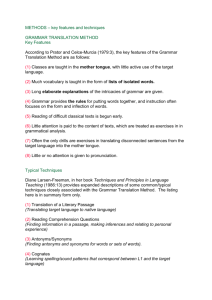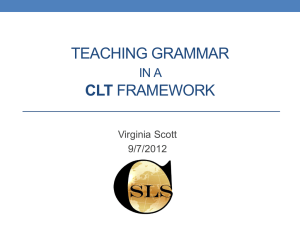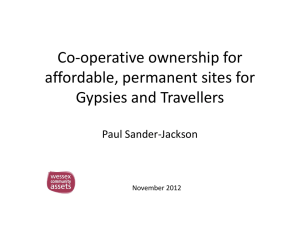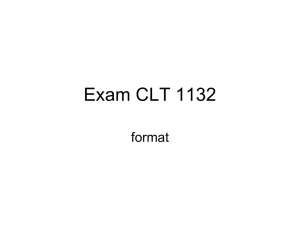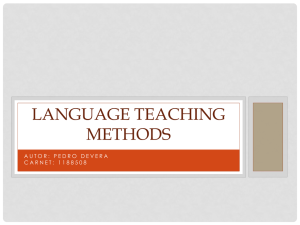English Language Teaching Methodology
advertisement
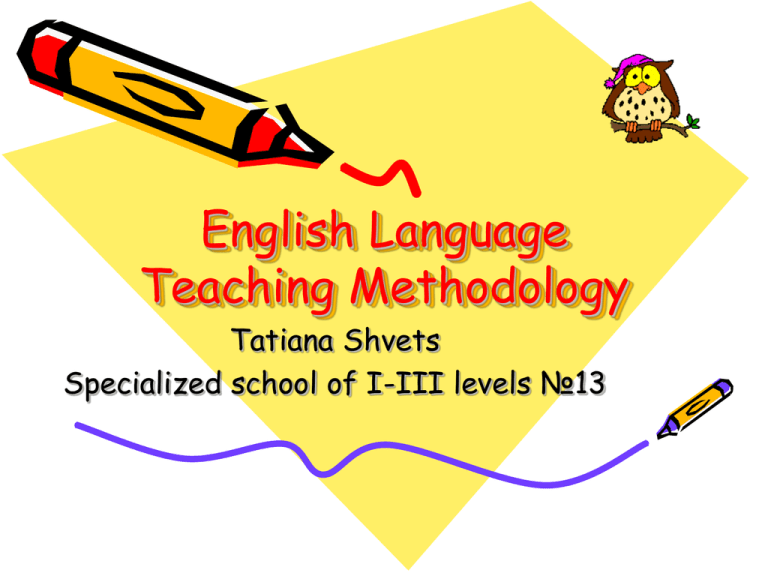
English Language Teaching Methodology Tatiana Shvets Specialized school of I-III levels №13 English Language Teaching Methodology Methodology Approach Method Curriculum/ Syllabus Technique Principles of Language Learning COG NI TI VE AUTO MATI CITY MEA NING FUL LEAR NING ANTICI PATION OF RE WARDS AFFE CTI VE INTRIN SIC MOTI VATI ON STRA TEGIC INVEST MENT LANGU AGE EGO SELGCONFI DENCE RISKTAL KING LIN GUIS TIC LANGU AGECULTURE CON NECTI ON NATIVE LANGU AGE EFFECT INTER LANGU AGE COMMU NICA TIVE COMPE TENCE The Grammar Translation Method (1) Classes are taught in the mother tongue, with little active use of the target language. (2) Much vocabulary is taught in the form of lists of isolated words. (3) Long elaborate explanations of the intricacies of grammar are given. (4) Grammar provides the rules for putting words together, and instruction often focuses on the form and inflection of words. (5) Reading of difficult classical texts is begun early. (6) Little attention is paid to the content of texts, which are treated as exercises in in grammatical analysis. (7) Often the only drills are exercises in translating disconnected sentences from the target language into the mother tongue. (8) Little or no attention is given to pronunciation. Typical Techniques (1) Translation of a Literary Passage (Translating target language to native language) (2) Reading Comprehension Questions (Finding information in a passage, making inferences and relating to personal experience) (3) Antonyms/Synonyms (Finding antonyms and synonyms for words or sets of words). (4) Cognates (Learning spelling/sound patterns that correspond between L1 and the target language) (5) Deductive Application of Rule (Understanding grammar rules and their exceptions, then applying them to new examples) (6) Fill-in-the-blanks (Filling in gaps in sentences with new words or items of a particular grammar type). (7) Memorization (Memorizing vocabulary lists, grammatical rules and grammatical paradigms) (8) Use Words in Sentences (Students create sentences to illustrate they know the meaning and use of new words) (9) Composition (Students write about a topic using the target language) The Direct Method (1) Classroom instruction is conducted exclusively in the target language. (2) Only everyday vocabulary and sentences are taught. (3) Oral communication skills are built up in a carefully traded progression organized around question-and-answer exchanges between teachers and students in small, intensive classes. (4) Grammar is taught inductively. (5) New teaching points are taught through modeling and practice. (6) Concrete vocabulary is taught through demonstration, objects, and pictures; abstract vocabulary is taught by association of ideas. (7) Both speech and listening comprehension are taught. (8) Correct pronunciation and grammar are emphasized. Typical Techniques 1) Reading Aloud (Reading sections of passages, plays or dialogues out loud) (2) Question and Answer Exercise (Asking questions in the target language and having students answer in full sentences) (3) Student Self-Correction (Teacher facilitates opportunities for students to self correct using follow-up questions, tone, etc) 4) Conversation Practice (Teacher asks students and students ask students questions using the target language) (5) Fill-in-the-blank Exercise (Items use target language only and inductive rather than explicit grammar rules) (6) Dictation (Teacher reads passage aloud various amount of times at various tempos, students writing down what they hear) (7) Paragraph Writing (Students write paragraphs in their own words using the target language and various models) The Audiolingual Method New material is presented in dialogue form There is a dependence on mimicry, memorizing of set phrases and overlearning. Structures are sequenced by means of contrastive analysis and taught one at a time Structural patterns are taught using repetitive drills. There is a little or no grammatical explanation. Grammar is taught by inductive analogy rather than explanation. Vocabulary is strictly limited and learned in context The Audiolingual Method There is much use of tapes, language labs, and visual aids. Great importance is attached to pronunciation. Very little use of the mother tongue by teachers is permitted. Successful responses are immediately reinforced. There is great effort to get students to produce error-free utterances. There is a tendency to manipulate language and disregard content. Typical Techniques 1)Dialog Memorization (Students memorize an opening dialog using mimicry and applied role-playing) (2) Backward Build-up (Expansion Drill) (Teacher breaks a line into several parts, students repeat each part starting at the end of the sentence and "expanding" backwards through the sentence, adding each part in sequence) (3) Repitition Drill (Students repeat teacher's model as quickly and accurately as possible) (4) Chain Drill (Students ask and answer each other one-by-one in a circular chain around the classroom ) (5) Single Slot Substitution Drill • (Teacher states a line from the dialog, then uses a word or a phrase as a "cue" that students, when • repeating the line, must substitute into the sentence in the correct place) (6) Multiple-slot Substitution Drill (Same as the Single Slot drill, except that there are multiple cues to be substituted into the line) (7) Transformation Drill (Teacher provides a sentence that must be turned into something else, for example a question to be turned into a statement, an active sentence to be turned into a negative statement, etc) (8) Question-and-answer Drill (Students should answer or ask questions very quickly) (9) Use of Minimal Pairs (Using contrastive analysis, teacher selects a pair of words that sound identical except for a single sound that typically poses difficulty for the learners - students are to pronounce and differentiate the two words) (10) Complete the Dialogue (Selected words are erased from a line in the dialog - students must find and insert) (11) Grammar Games (Various games designed to practice a grammar point in context, using lots of repetition) Community Language Learning 1) Students are to be considered as "learner-clients" and the teacher as a "teacher-councelor". (2) A relationship of mutual trust and support is considered essential to the learning process. (3) Students are permitted to use their native language, and are provided with translations from the teacher which they then attempt to apply. 4) Grammar and vocabulary are taught inductively. (5) "Chunks" of target language produced by the students are recorded and later listened to - they are also transcribed with native language equivalents to become texts the students work with. (6) Students apply the target language independently and without translation when they feel inclined/ confident enough to do so. (7) Students are encouraged to express not only how they feel about the language, but how they feel about the learning process, to which the teacher expresses empathy and understanding. (8) A variety of activities can be included (for example, focusing on a particular grammar or pronunciation point, or creating new sentences based on the recordings/transcripts). Typical Techniques (1) Tape Recording Student Conversation (Students choose what they want to say, and their target language production is recorded for later listening/dissemination) (2) Transcription (Teacher produces a transcription of the tape-recorded conversation with translations in the mother language - this is then used for follow up activities or analysis) 3) Reflection on Experience (Teacher takes time during or after various activities to allow students to express how they feel about the language and the learning experience, and the teacher indicates empathy/understanding) (4) Reflective Listening (Students listen to their own voices on the tape in a relaxed and reflective environment) (5) Human Computer (Teacher is a "human computer" for the students to control - the teacher stating anything in the target language the student wants to practice, giving them the opportunity to self correct) (6) Small Group Tasks (Students work in small groups to create new sentences using the transcript, afterwards sharing them with the rest of the class) The Silent Way Learning is facilitated if the learner discovers or creates rather than remembers and repeats what is to be learnt. Learning is facilitated by accompanying (mediating) physical objects Learning is facilitated by problem-solving involving the material to be learned. Typical Techniques (1) Sound-Color Chart (The teacher refers students to a color-coded wall chart depicting individual sounds in the target language - students use this to point out and build words with correct pronunciation) (2) Teacher's Silence (Teacher is generally silent, only giving help when it is absolutely necessary) (3) Peer Correction (Students encouraged to help each other in a cooperative and not competitive spirit) 4) Rods (Rods are used to trigger meaning, and to introduce or actively practice language. They can symbolize whatever words are being taught and be manipulated directly or abstractly to create sentences) (5) Self-correction Gestures (Teacher uses hands to indicate that something is incorrect or needs changing - eg. using fingers as words then touching the finger/word that is in need of correction) (6) Word Chart (Words are depicted on charts, the sounds in each word corresponding in color to the Sound-Color Chart described above - students use this to build sentences) (7) Fidel Chart (A chart that is color-coded according to the sound-color chart but includes the various English spellings so that they can be directly related to actual sounds) (8) Structured Feedback (Students are invited to make observations about the day's lesson amd what they have learned) Suggestopedia (1) Learning is facilitated in an environment that is as comfortable as possible, featuring soft cushioned seating and dim lighting. (2) "Peripheral" learning is encouraged through the presence in the learning environment of posters and decorations featuring the target language and various grammatical information. (3) The teacher assumes a role of complete authority and control in the classroom. (4) Self-perceived and psychological barriers to learners' potential to learn are "desuggested". (5) Students are encouraged to be child-like, take "mental trips with the teacher" and assume new roles and names in the target language in order to become more "suggestible". (6) Baroque music is played softly in the background to increase mental relaxation and potential to take in and retain new material during the lesson. (7) Students work from lengthy dialogs in the target language, with an accompanying translation into the students' native language. (8) Errors are tolerated, the emphasis being on content and not structure. Grammar and vocabulary are presented and given treatment from the teacher, but not dwelt on. (9) Homework is limited to students re-reading the dialog they are studying - once before they go to sleep at night and once in the morning before they get up. (10) Music, drama and "the Arts" are integrated into the learning process as often as possible. Typical Techniques (1) Classroom Set-up (Emphasis is placed on creating a physical environment that does not "feel" like a normal classroom, and makes the students feel as relaxed and comfortable as possible) (2) Peripheral Learning (Students can absorb information "effortlessly" when it is perceived as part of the environment, rather than the material "to be attended to") (3) Positive Suggestion (Teachers appeal to students' consciousness and subconscious in order to better orchestrate the "suggestive" factors involved in the learning situation) (4) Visualization (Students are asked to close their eyes and visualize scenes and events, to help them relax, facilitate positive suggestion and encourage creativity from the students) 5) Choose a New Identity (Students select a target language name and/or occupation that places them "inside" the language language they are learning) (6) Role-play (Students pretend temporarily that they are somone else and perform a role using the target language) (7) First Concert (Teacher does a slow, dramatic reading of the dialog synchronized in intonation with classical music) (8) Second Concert (Students put aside their scripts and the teacher reads at normal speed according to the content, not the accompanying pre-Classical or Baroque music - this typically ends the class for the day) (9) Primary Activation (Students "playfully" reread the target language out loud, as individuals or in groups) (10) Secondary Activation (Students engage in various activities designed to help the students learn the material and use it more spontaneously - activities include singing, dancing, dramatizations and games - "communicative intent" and not "form" being the focus) Total Physical Response The teacher directs and students "act" in response – “The instructor is the director of a stage play in which the students are the actors“. Listening and physical response skills are emphasized over oral production. The imperative mood is the most common language function employed, even well into advanced levels. Interrogatives are also heavily used. Humor is injected into the lessons to make them more enjoyable for learners. Students are not required to speak until they feel naturally ready or confident enough to do so. Grammar and vocabulary are emphasized over other language areas. Typical Techniques Using Commands to Direct Behavior (The use of commands requiring physical actions from the students in response is the major teaching technique) Role Reversal (Students direct the teacher and fellow learners) Action Sequence (Teacher gives interconnected directions which create a sequence of actions [also called an "operation"] - as students progress in proficiency, more and more commands are added to the action sequence The Natural Approach Preproduction – Developing listening skills Early Production – students struggle with the language and make many errors witch are corrected Extending Production – promoting fluency through a variety of activities games discussions roleplays activities Group work dialogues The Communicative Language Teaching Approach Basic Features of CLT 1) An emphasis on learning to communicate through interaction in the target language. (2) The introduction of authentic texts into the learning situation. (3) The provision of opportunities for learners to focus, not only on the language but also on the learning process itself. (4) An enhancement of the learner's own personal experiences as important contributing elements to classroom learning. (5) An attempt to link classroom language learning with language activation outside the classroom. The Communicative Language Teaching in Comparison with the Audiolingual Method (1) CLT: Meaning is paramount. ALM: Attends to structure and form more than meaning. (2) CLT: Dialogs, if used, center around communicative functions and are not normally memorized. ALM: Demands more memorization of structure-based dialogs. (3) CLT: Contextualization is a basic premise. ALM: Language items are not necessarily contextualized. (4) CLT: Language learning is learning to communicate. ALM: Language Learning is learning structures, sounds or words. (5) CLT: Effective communication is sought. ALM: Mastery or "overlearning" is sought. (6) CLT: Drilling may occur, but peripherially. ALM: Drilling is a central technique. (7) CLT: Comprehensible pronunciation is sought. ALM: Native-speaker-like pronunciation is sought. (8) CLT: Any device which helps the learners is accepted - varying according to their age, interest, etc. ALM: Grammatical explanation is avoided. (9) CLT: Attempts to communicate may be encouraged from the very beginning. ALM: Communicative activities only come after a long process of rigid drills and exrecises. (10) CLT: Judicious use of native language is accepted where feasible. ALM: The use of the students' native language is forbidden. (11) CLT: Translation may be used where students need or benefit from it. ALM: Translation is forbidden at early levels. (12) CLT: Reading and writing can start from the first day, if desired. ALM: Reading and writing are deferred until speech is mastered. 13) CLT: The target linguistic system will be learned best through the process of struggling to communicate. ALM: The target linguistic system will be learned through the overt teaching of the patterns of the system. (14) CLT: Communicative competence is the desired goal. ALM: Linguistic competence is the desired goal. (15) CLT: Linguistic variation is a central concept in materials and methods. ALM: Varieties of language are recognized but not emphasized. (16) CLT: Sequencing is determined by any consideration of content function, or meaning which maintains interest. ALM: The sequence of units is determined solely on principles of linguistic complexity. (17) CLT: Teachers help learners in any way that motivates them to work with the language. ALM: The teacher controls the learners and prevents them from doing anything that conflicts with the theory. (18) CLT: Language is created by the individual often through trial and error. ALM: "Language is habit" so error must be prevented at all costs. (19) CLT: Fluency and acceptable language is the primary goal: accuracy is judged not in the abstract but in context. ALM: Accuracy, in terms of formal correctness, is a primary goal. (20) CLT: Students are expected to interact with other people, either in the flesh, through pair and group work, or in their writings. ALM: Students are expected to interact with the language system, embodied in machines or controlled materials. (21) CLT: The teacher cannot know exactly what language the students will use. ALM: The teacher is expected to specify the language that students are to use. (22) CLT: Intrinsic motivation will spring from an interest in what is being communicated by the language. ALM: Intrinsic motivation will spring from an interest in the structure of the language. Types of Learning Associated with The CLT Approach Interactive learning Learnercentered Learning Cooperative Learning Contentbased Learning Task-based Learning The PPP Approach to Communicative Language teaching Presentation Practice Production • -> Be a risk-taker and see errors as an essential, positive part of the learning process; • -> See peers (ie, your fellow teachers) as sources of learning, who may or may not be "right"; • -> See learning as a cooperative and collaberative exercise, not a competitive one; • -> Try to take responsibility for your own learning, set your own goals and develop strategies to achieve them. THANK YOU!
